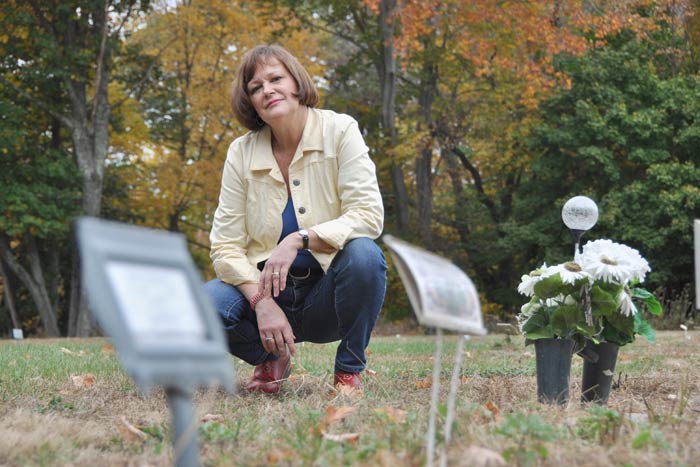[ad_1]
Lisa Curtis, Office Manager at New Paltz Rural Cemetery, in the Special Needs Section of Plains Road Cemetery. (photo by Lauren Thomas)
This is the “Special Needs Section†of the New Paltz Rural Cemetery. Like all euphemisms, especially those relating to death, the title aims to soften a harsh reality.
This reality is complex: we all die, of course. But some of us die far from home. Some of us die lost, with no memory of our friends or family. Some of us die in back alleys or in emergency rooms. Some die face down in drainage ditches or under frozen sheets of broken cardboard. Some of us, in other words, die broken, alone, forgotten. These are the people whose bodies have for thousands of years filled what is most commonly known as the “potter’s fieldsâ€.
As awkward and inaccurate as it may be, no one at rural New Paltz cemetery would choose to have the special needs section portrayed by that dismal title. Better to mysteriously understate the markerless area along the cemetery’s northwest border than to bring additional indignity to the people whose bodies are buried there.
The term “potter’s field†has biblical roots. The story goes that after betraying Jesus, a desolate Judas threw the 30 pieces of silver he had received for his work at the feet of the high priests who had served him. Money was considered stained with blood, so priests used it to buy land where clay was dug for pottery. Useless for agriculture, the land was considered a suitable place to bury criminals, the forgotten and the poor.
The history of the potter’s fields is dark. In New York City alone, an estimated one million destitute and forgotten people were buried – most in trenches – on Hart Island, off the coast of the Bronx. Closer to home, the bodies of the fools, the poor and the helpless were routinely wrapped in sheets and dumped in shallow graves surrounding the Ulster County Poorhouse, on land that now includes the County Fairgrounds.
New Paltz Rural Cemetery was established in 1861, at a time when traditional family burial in cemeteries and near homes was fading. Civil war raged, causing a sudden need for more burial space. As of those days, nearly 7,000 bodies have rested there on 32 acres of land framed by a view of Shawangunk Ridge.
The special needs section of the cemetery, which was established in 1982, now includes 25 rows of burial plots located on the northwest side of the cemetery. It’s easy to miss, as no commemorative stones are allowed (which makes maintenance easier). Instead, plastic stakes with a name and a year of burial and here and there a stone in the ground mark the places where the bodies of the needy now lie.
In Ulster County, the history of the destitute dead is being studied by the County Social Services Department. The person may be known to the department, but may also be from outside the county. According to the commissioner of the department Michael Iapoce, the financial situation of a person is sought. If it is determined that the person is in fact indigent, the ministry will pay a funeral home $ 1,800 for basic funeral services, including a casket. The cemetery will receive $ 1,000 to cover its costs, he said. Additional money may be available for things like transporting the body.
Lisa Curtis is the office manager of the New Paltz Rural Cemetery Association, the non-profit organization that manages the Plains Road Cemetery. She knows better than anyone how many stories are buried in the expanse of the cemetery. Some are of historical interest. Some are inspiring. But the stories of the Special Needs Section are invariably heartbreaking.
The circumstances of death can vary from person to person, but rich or poor they have one thing in common: “Grieving is grieving, and everyone is grieving,†Curtis says.
Curtis remembers the family member who was able to place a gravestone in the ground over his mother’s grave 20 years after her death.
The association updates its archives, creates a database that will make it easier to identify and even memorize the people who are buried there.
Sometimes people come to the door of the association looking for the graves of missing relatives who are buried in the special needs section.
“They almost apologize. I’m trying to make them understand that it’s not necessary, â€Curtis says.
While searching the cemetery archives, Curtis came across what appeared to be a curious anomaly: four people buried on the same day in May 1986 in the special needs section. It didn’t seem possible. She contacted Carol Johnson, city historian and coordinator of the Haviland-Heidgerd Historical Collection, who was involved in efforts to improve the cemetery’s historical records. Johnson confirmed the record to be accurate and tragic.
All four burials were the result of a house fire that claimed the lives of four Kingston residents; an 83-year-old grandfather, his 62-year-old son and two of the son’s children, a four-year-old daughter and her 13-year-old sister. All were buried, side by side, in the special needs section.
The blaze made headlines at the time, with neighbors expressing concern that the house was a known Midtown fire trap. This controversial fire and its victims have long been forgotten, an iconic fate of every lost or forgotten soul in the realm of every potter everywhere.
“It’s sad,†Curtis says, reflecting on some of the people and stories she’s seen at her job. “No one should be forgotten. My grandmother told me that no one should die without someone to hold their hand.
[ad_2]

